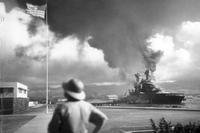The amount of energy discharged from a nuclear bomb recently tested by North Korea may show the device used plutonium, which would mean the country hasn't yet found the other route to the weapon, according to an arms-control expert.
North Korea on Feb. 12 announced its third test of a nuclear device. The underground detonation has escalated tensions in the region. The U.S. flew pairs of stealth aircraft over South Korea, including F-22 fighter jets and nuclear-capable B-2 bombers, in a show of force. The North threatened retaliation and on April 2 pledged to restart a closed reactor to boost production of the weapons material.
North Korea has steadily increased the explosive power, or yield, of its nuclear tests, to six to seven kilotons in February, from about two kilotons in 2009 and from less than a kiloton in 2006, according to a Feb. 12 report from the Congressional Research Service. The first two are believed to have used plutonium rather than highly enriched uranium. Obtaining the fissile material is the main hurdle in building a nuclear weapon.
"It looks more as if they're sort of gradually improving a design that they've been working on," said Hans Kristensen, director of the Nuclear Information Project at the Federation of American Scientists, an arms-control organization based in Washington that supports the reduction of nuclear weapons. "You could argue and say, 'Well, maybe it's more likely a plutonium device versus them starting all over on a totally new design based on uranium.'"
Still, because so little is known about North Korea's activities, "it could go either way," he said in a telephone interview. "We really don't know one way or the other."
The U.S. successfully pursued both paths to the bomb during the Manhattan Project in the 1940s, Kristensen said. Early tests of U.S. nuclear weaponry yielded about 15 and 20 kilotons, he said. India and Pakistan's first atomic devices yielded about 10 to 12 kilotons, he said.
The difference in yields suggests Pyongyang is "still not very good at producing this," Kristensen said.
A third test of a plutonium-based bomb would also diminish North Korea's stockpile of the weapons-grade material. The country is estimated to have between 30 and 50 kilograms of separated plutonium, enough for four to seven weapons, according to the CRS report.
While North Korea has acknowledged a uranium enrichment program, it previously said its purpose was to produce fuel for nuclear power. That may have changed under the regime of Kim Jong Un, which last month called for bolstering its nuclear weapons production.
North Korea's latest atomic test, along with its December launch of a satellite into orbit using a Taepo Dong 2 rocket and recent display of an intercontinental ballistic missile, demonstrates a "commitment to develop long-range missile technology that could pose a direct threat to the United States," James Clapper, director of National Intelligence, said in prepared remarks last month to the Senate Intelligence Committee.
North Korea probably won't have the capacity to attack the U.S. with nuclear missiles "for many years," and its ability to strike South Korea is very limited, according to Siegfried Hecker, a Stanford University professor and former Los Alamos National Laboratory director who has repeatedly traveled to the country to report on its nuclear facilities.
"Nevertheless, this is an uneasy situation with a potential for miscalculations from a young and untested leader," he said in an April 2 article from Stanford's Center for International Security and Cooperation.









